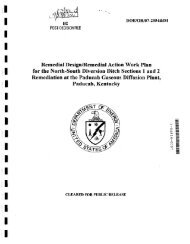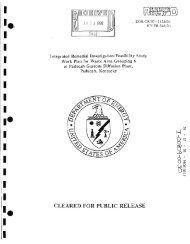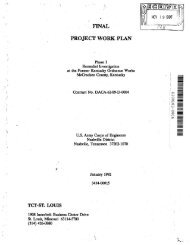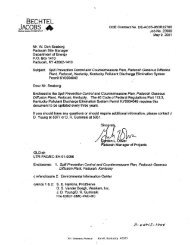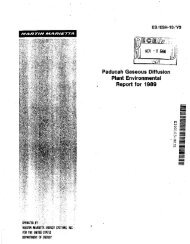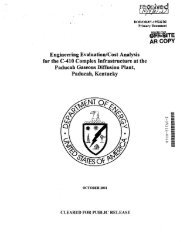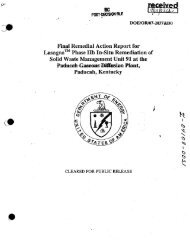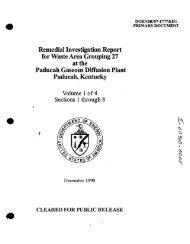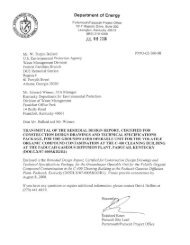1 - paducah environmental information center
1 - paducah environmental information center
1 - paducah environmental information center
You also want an ePaper? Increase the reach of your titles
YUMPU automatically turns print PDFs into web optimized ePapers that Google loves.
Annual Site Environmental Report for 1999<br />
Non:radioliog:ical<br />
Envilron menlalSu rvei Ilance<br />
Abstract<br />
The nonradiological <strong>environmental</strong> surveillance program at the Paducah Site assesses the effects of DOE<br />
operations on the site and the surrounding environment. Surveillance includes analyses of air, surface<br />
water, groundwater (Section 9), sediment, soil, vegetation, terrestrial wildlife, and fish and other aquatic life.<br />
Surveillance results for 1999 were similar to results reported in previous ASERs.<br />
Introduction<br />
Surface Water<br />
N onradiological <strong>environmental</strong><br />
surveillance at the Paducah Site involves<br />
sampling and analysis of surface water,<br />
groundwater (see Section 9 for groundwater<br />
surveillance results), sediment, soil, terrestrial<br />
wildlife, and fish and other aquatic life. This<br />
section discusses the results of surveillance<br />
activities.<br />
Ambient Air<br />
As a result of the transfer of the production<br />
part of the plant to USEC in 1993, major air<br />
emission sOUrces were transferred to USEC.<br />
Therefore, 'the Paducah Site is not required to<br />
conduct ambient air monitoring for<br />
nonradiological ,parameters.<br />
Surface water monitoring downstream of<br />
,~DES outfalls is not required by the KPDES<br />
peimit. However, it is performed at the Paducah<br />
Site as part of the <strong>environmental</strong>. surveillance<br />
program. The net impact of the Paducah Site's<br />
activities on surface w~ters 'is evaluated by<br />
comparing data from samples collected at<br />
reference locations (Mas sac Creek and the Ohio<br />
River) and locations upstream and downstream<br />
of paDP at Little Bayou Creek and Bayou Creek<br />
(Figure8.1). . No sample point exists for<br />
upstream Little Bayou Creek as the watershed is<br />
insufficient to develop adequate flow to monitor.<br />
Most water in Little Bayou Creek is comprised of<br />
discharges from plant outfalls. Background<br />
water quality is derived from upstream Bayou<br />
Creek (L 1). L 29 and L 64 are reference<br />
waterways also used for comparisons with data<br />
for Bayou and Little Bayou creeks.<br />
Bimonthly surface water samples had been<br />
collected at six locations (L 1, L 5, L 10, L 11, L<br />
29, and L 64), In 1999, L 30 (Ohio River<br />
Nonradiological Environmental Surveillance<br />
8-1



